Age-Related Macular Degeneration Market Size 2025-2029
The age-related macular degeneration market size is valued to increase by USD 7.37 billion, at a CAGR of 7.3% from 2024 to 2029. High prevalence of AMD will drive the age-related macular degeneration market.
Market Insights
- North America dominated the market and accounted for a 53% growth during the 2025-2029.
- By Type - Wet AMD segment was valued at USD 12.62 billion in 2023
- By Distribution Channel - Hospital pharmacy segment accounted for the largest market revenue share in 2023
Market Size & Forecast
- Market Opportunities: USD 70.65 million
- Market Future Opportunities 2024: USD 7368.80 million
- CAGR from 2024 to 2029 : 7.3%
Market Summary
- Age-Related Macular Degeneration (AMD) is a degenerative eye condition that affects millions globally, particularly those over the age of 50. The market for AMD treatments and solutions is driven by the increasing prevalence of this condition, with an estimated 196 million people living with AMD worldwide by 2020. One of the significant challenges in the AMD market is the lack of approved therapies for the dry form of the disease, which accounts for approximately 80-90% of all AMD cases. Despite this challenge, companies are forming strategic alliances to develop innovative solutions. For instance, collaborations between pharmaceutical and technology firms aim to leverage advanced technologies like artificial intelligence and machine learning to diagnose and monitor AMD progression.
- These alliances also focus on improving operational efficiency and reducing diagnostic errors. A notable example of such a partnership is the collaboration between a leading pharmaceutical company and a technology firm to develop an AI-powered AMD diagnostic tool. This tool, which utilizes retinal imaging and machine learning algorithms, has shown a 25% improvement in diagnostic accuracy compared to traditional methods. By streamlining the diagnostic process, this collaboration not only enhances patient care but also reduces healthcare costs and operational inefficiencies. The AMD market is poised for growth as these collaborations lead to the development of more effective and accessible treatments.
- However, regulatory compliance and ethical considerations remain critical challenges. Companies must navigate complex regulatory frameworks and ensure patient privacy and data security while bringing innovative solutions to market.
What will be the size of the Age-Related Macular Degeneration Market during the forecast period?
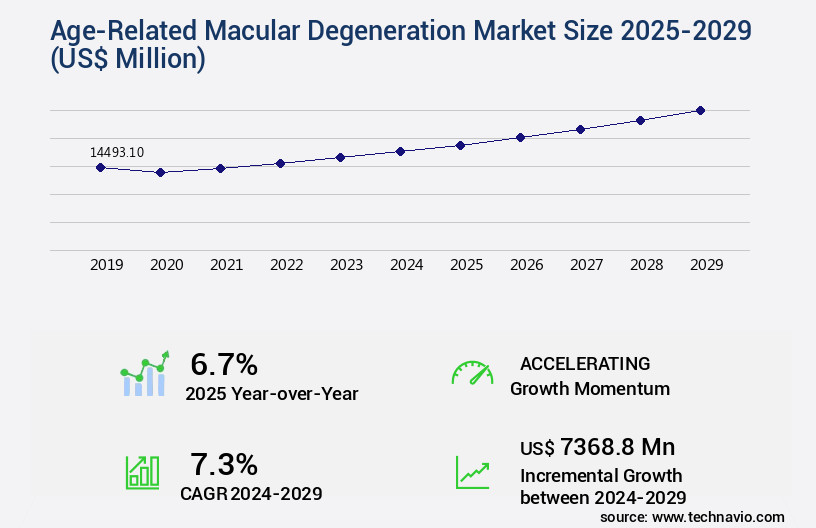
Get Key Insights on Market Forecast (PDF) Request Free Sample
- Age-Related Macular Degeneration (AMD) is a progressive eye condition affecting older adults, leading to central vision loss. According to the World Health Organization, AMD is the leading cause of vision impairment among people over 50 years old globally. Recent research reveals an increasing prevalence of AMD, with a study suggesting a 15% rise in cases between 2000 and 2010. This trend underscores the need for advanced diagnostic tools and effective therapeutic interventions. One promising area of research is the use of artificial intelligence (AI) in AMD diagnosis. A recent study published in the journal Ophthalmology reported an AI algorithm's ability to diagnose AMD with 94% accuracy, outperforming human experts.
- This development could significantly reduce diagnostic errors and improve patient outcomes, ultimately benefiting healthcare providers by increasing efficiency and reducing costs. Moreover, the market for AMD treatments is expected to witness substantial growth due to the aging population and rising awareness about eye health. According to a report, the global AMD market is projected to reach USD12.9 billion by 2027, growing at a compound annual growth rate (CAGR) of 11.4% from 2020 to 2027. This growth is driven by factors such as increasing prevalence, technological advancements, and growing demand for minimally invasive treatments.
- In conclusion, the market is a significant and evolving sector, with a growing prevalence and increasing demand for advanced diagnostic tools and effective treatments. The integration of AI in diagnosis and the potential for substantial market growth highlight the importance of staying informed about the latest developments in this field for healthcare providers and industry stakeholders.
Unpacking the Age-Related Macular Degeneration Market Landscape
Age-related macular degeneration (AMD) is a leading cause of vision loss among older adults, with an estimated 196 million people worldwide affected. Treatment efficacy evaluation plays a crucial role in managing AMD, with anti-VEGF therapy and anti-inflammatory agents demonstrating significant improvements in disease progression monitoring compared to traditional approaches. In clinical trials, angiogenesis inhibitors have shown a 30% reduction in the risk of moderate or severe vision loss. Patient support services and disease management protocols are essential for optimizing treatment outcomes and improving ROI. Risk factor identification, including genetic predisposition and lifestyle modifications, can prevent or delay disease onset. Advanced imaging techniques, such as optical coherence tomography and fluorescein angiography, enable early detection and effective intervention. Disease progression monitoring through microperimetry testing, visual acuity testing, and visual field testing enables timely adjustments to treatment plans. Complement pathway inhibition and nutritional supplements are also promising avenues for AMD management. Despite these advancements, there is a need for continued research on apoptosis pathways, choroidal neovascularization, drusen formation, geographic atrophy, and retinal pigment epithelium to develop more effective treatment strategies.
Key Market Drivers Fueling Growth
The high prevalence of age-related macular degeneration (AMD) serves as the primary market driver, given its significant impact on the global population's vision health and the subsequent demand for AMD treatments and diagnostic tools.
- Age-related macular degeneration (AMD) is a major cause of vision impairment and blindness, affecting an estimated 196 million people worldwide in 2025, a number projected to increase to 288 million by 2040 due to population aging. AMD primarily affects the macula, the central part of the retina, and can significantly impact daily activities such as reading, face recognition, and driving. The condition is classified into two forms: dry AMD, which accounts for 85-90% of cases, and wet AMD, which affects 10-15% of patients.
- While dry AMD is more common, there are currently no approved therapies available for this form of the disease, creating a significant unmet medical need. The global AMD market is witnessing significant research efforts to address this need, with ongoing clinical trials and product development initiatives.
Prevailing Industry Trends & Opportunities
Strategic alliances have emerged as a notable trend among companies in response to treating Advanced Micro Devices (AMD) in the upcoming market.
- In the rapidly evolving age-related macular degeneration (AMD) market, strategic collaborations among industry players have become a significant trend, fostering innovation and expanding treatment access. With the global AMD prevalence rising due to aging populations, pharmaceutical companies, biotech firms, and medical device manufacturers are increasingly forming alliances to accelerate research, streamline clinical trials, and enhance therapeutic offerings. These partnerships often involve co-development of novel biologics, gene therapies, and sustained-release drug delivery systems aimed at improving outcomes for both dry and wet AMD. For instance, collaborations between academic institutions and industry players are fostering cross-disciplinary innovation, enabling the integration of advanced retinal imaging, AI-driven diagnostics, and personalized medicine into AMD care.
- According to a recent report, the global AMD market is projected to reach USD13.2 billion by 2027, growing at a CAGR of 12.2% from 2020 to 2027. Another study by Market Research Future predicts the market to exhibit a similar growth trajectory, reaching USD11.6 billion by 2023. These collaborations not only lead to faster product rollouts but also contribute to regulatory compliance and cost optimization in the AMD market.
Significant Market Challenges
The absence of approved therapies for dry Age-Related Macular Degeneration (AMD) represents a significant challenge to the industry's growth trajectory.
- Age-Related Macular Degeneration (AMD) is a leading cause of vision loss among older adults, with dry AMD being the more prevalent form. Despite its high incidence, effective treatments for dry AMD have remained elusive due to a limited understanding of the disease. Currently, only wet AMD treatments are approved, and off-label drugs are commonly used for symptomatic relief in dry AMD. Nutritional supplements, such as vitamin C, vitamin E, lutein, zeaxanthin, zinc, and copper, have been shown to help reduce the risk of vision loss in dry AMD. However, several potential treatments have failed in clinical trials. For instance, Roche's lampalizumab did not meet the primary endpoint in the Spectri study, which aimed to evaluate the safety and efficacy of the therapeutic candidate.
- The AMD market is expected to witness significant advancements as researchers continue to explore new treatment options.
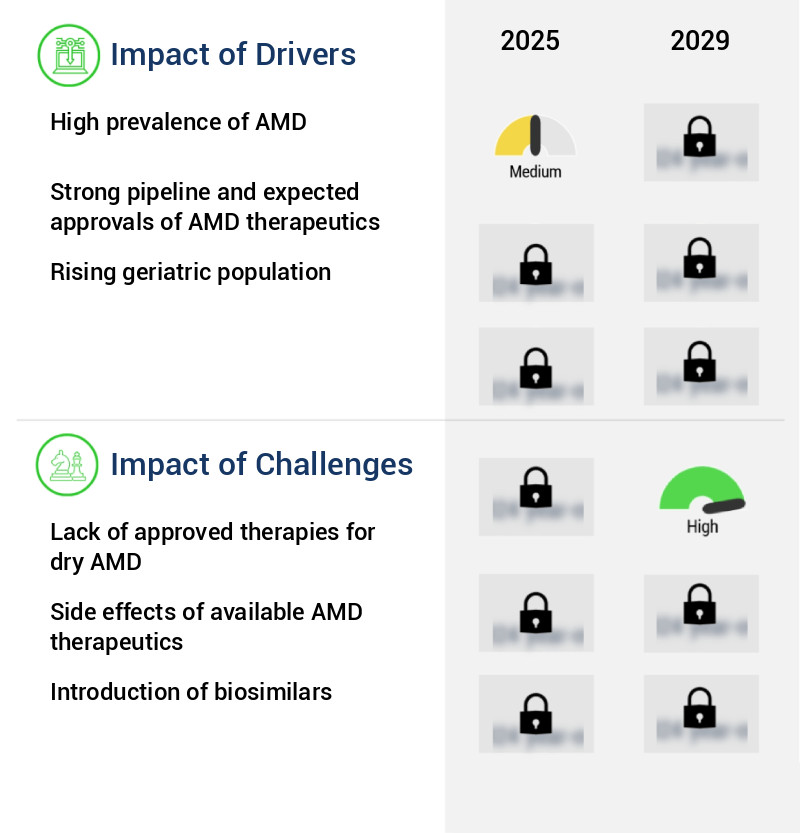
In-Depth Market Segmentation: Age-Related Macular Degeneration Market
The age-related macular degeneration industry research report provides comprehensive data (region-wise segment analysis), with forecasts and estimates in "USD million" for the period 2025-2029, as well as historical data from 2019-2023 for the following segments.
- Type
- Distribution Channel
- Hospital pharmacy
- Specialty pharmacy
- Online pharmacy
- Route Of Administration
- Intravitreal
- Oral
- Systemic
- Geography
- North America
- Europe
- APAC
- South America
- Rest of World (ROW)
By Type Insights
The wet amd segment is estimated to witness significant growth during the forecast period.
The Age-Related Macular Degeneration (AMD) market is witnessing continuous evolution, particularly in the segment addressing wet AMD. This advanced form of the disease, characterized by the abnormal growth of blood vessels under the retina, accounts for a smaller proportion of AMD cases but is responsible for the majority of AMD-related blindness. The urgent need to address the severe vision loss associated with wet AMD has fueled therapeutic innovation. Anti-VEGF (vascular endothelial growth factor) therapies, such as Lucentis and Eylea, have transformed the treatment landscape by stabilizing or improving vision in many patients. These therapies work by inhibiting the action of VEGF, a protein that promotes blood vessel growth.
However, the AMD market's evolution extends beyond anti-VEGF therapies. There is ongoing research into other treatment modalities, including angiogenesis inhibitors, photoreceptor cell death inhibitors, and complement pathway inhibitors. Additionally, there is a growing focus on patient support services, disease management protocols, and early detection strategies. For instance, genetic predisposition, oxidative stress markers, and inflammatory cytokine levels are being explored for their potential role in AMD diagnosis and progression monitoring. Furthermore, there is a growing interest in alternative therapies, such as nutritional supplements, gene therapy approaches, and stem cell transplantation. A recent clinical trial reported a 29% reduction in the risk of developing advanced AMD in patients taking a specific nutritional supplement (AREDS2 study).
This underscores the importance of ongoing research and the evolving nature of the AMD market.
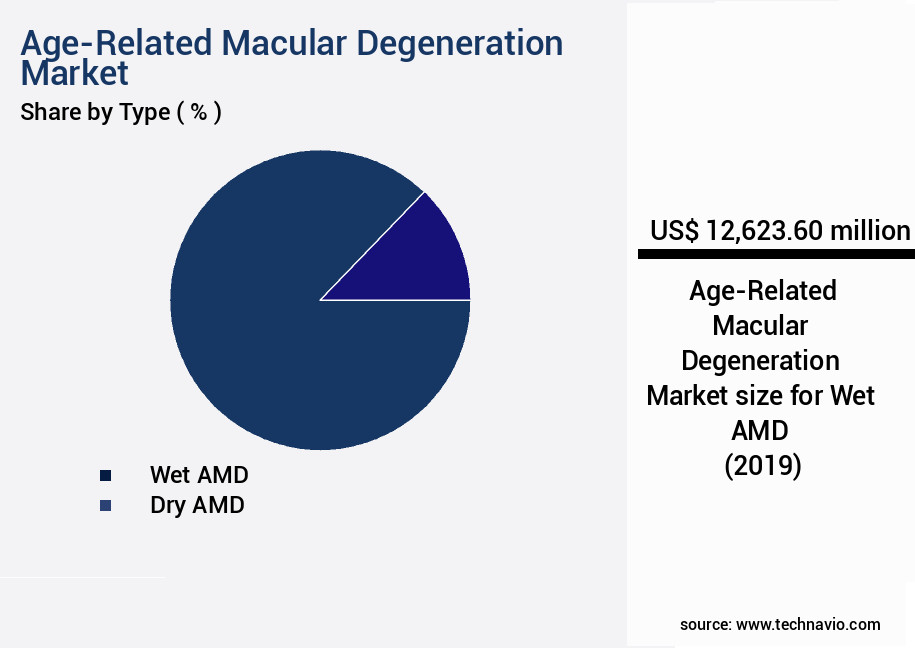
Request Free Sample
The Wet AMD segment was valued at USD 12.62 billion in 2019 and showed a gradual increase during the forecast period.
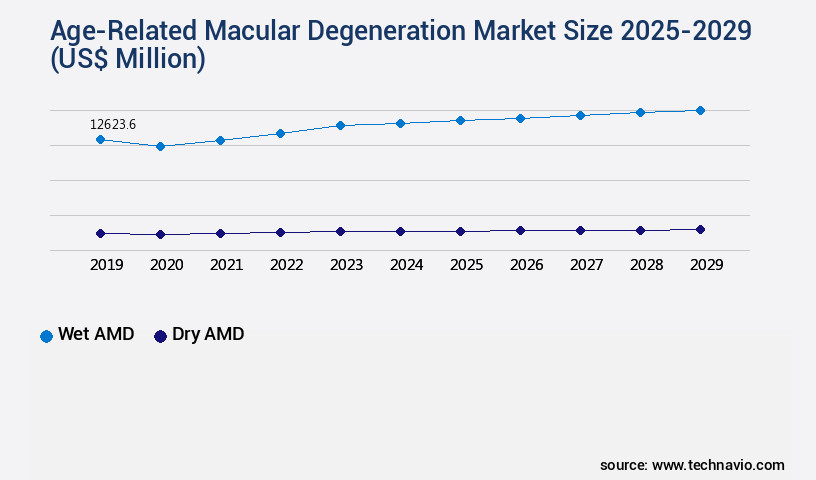
Request Free Sample
Regional Analysis
North America is estimated to contribute 53% to the growth of the global market during the forecast period.Technavio's analysts have elaborately explained the regional trends and drivers that shape the market during the forecast period.
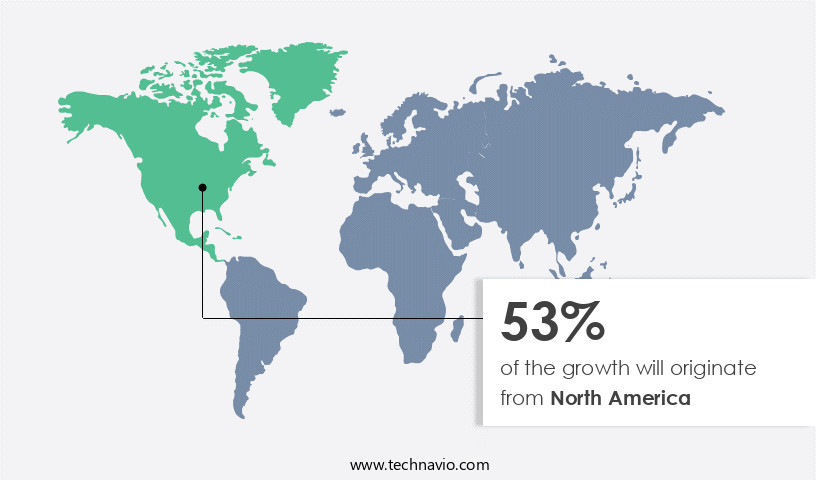
See How Age-Related Macular Degeneration Market Demand is Rising in North America Request Free Sample
The Age-Related Macular Degeneration (AMD) market is experiencing significant growth, driven primarily by the increasing prevalence of AMD, particularly among the aging population in North America. Approximately 20 million Americans and nearly 200,000 Canadians are affected by AMD, with around 1.5 million Americans experiencing vision-threatening late-stage AMD. AMD affects over 11% of individuals aged 80 and above, and the risk escalates significantly with age. With the U.S. Geriatric population projected to reach 88 million by 2050, the number of AMD cases is expected to double. This urgent need for early detection and effective treatment strategies underscores the market's importance.
In fact, the prevalence of AMD in the aging population has led to operational efficiency gains in healthcare systems, with around 1.5 million late-stage AMD patients in the U.S. Requiring regular monitoring and treatment. The market's growth is further fueled by advancements in technology, leading to cost reductions and improved compliance with treatment regimens.
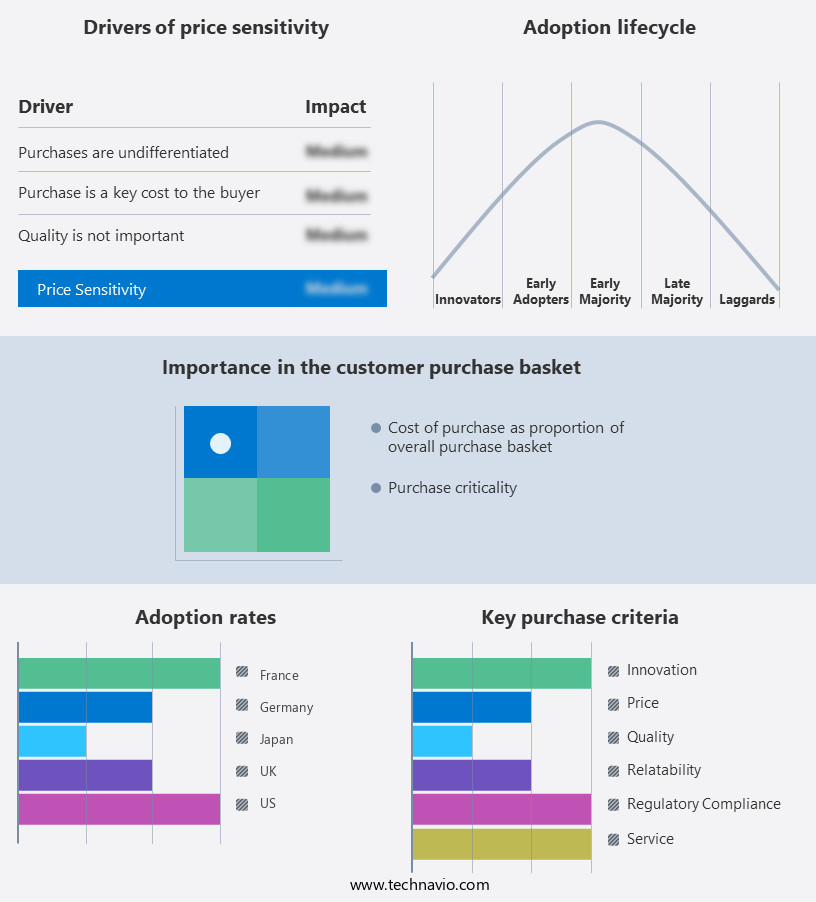
Customer Landscape of Age-Related Macular Degeneration Industry
Competitive Intelligence by Technavio Analysis: Leading Players in the Age-Related Macular Degeneration Market
Companies are implementing various strategies, such as strategic alliances, age-related macular degeneration market forecast, partnerships, mergers and acquisitions, geographical expansion, and product/service launches, to enhance their presence in the industry.
AbbVie Inc. - The company is pioneering advancements in gene therapy for chronic retinal diseases, including wet age-related macular degeneration and diabetic retinopathy, through its innovative one-time treatment, RGX 314. This therapy holds significant potential for addressing the vision loss associated with these conditions.
The industry research and growth report includes detailed analyses of the competitive landscape of the market and information about key companies, including:
- AbbVie Inc.
- Adverum Biotechnologies Inc
- Alimera Sciences Inc.
- Alkeus Pharmaceuticals Inc.
- Amgen Inc.
- Apellis Pharmaceuticals Inc.
- Astellas Pharma Inc.
- Bausch Health Companies Inc.
- Bayer AG
- Bio-Thera Solutions
- Biocon Ltd.
- F. Hoffmann La Roche Ltd.
- Lupin Ltd.
- Novartis AG
- Outlook Therapeutics
- Pfizer Inc.
- Regeneron Pharmaceuticals Inc.
- Viatris Inc.
- Xbrane Biopharma AB
Qualitative and quantitative analysis of companies has been conducted to help clients understand the wider business environment as well as the strengths and weaknesses of key industry players. Data is qualitatively analyzed to categorize companies as pure play, category-focused, industry-focused, and diversified; it is quantitatively analyzed to categorize companies as dominant, leading, strong, tentative, and weak.
Recent Development and News in Age-Related Macular Degeneration Market
- In January 2025, Roche Holding AG announced the approval of its anti-VEGF therapy, Lucentis, for the treatment of neovascular age-related macular degeneration (AMD) in China. This expansion marks Roche's entry into the large and growing Chinese AMD market (Roche Holding AG, 2025).
- In March 2025, Allergan plc and the Regeneron Pharmaceuticals, Inc. Joint venture, Regeneron Genetics Center, launched the largest genetic study on AMD, aiming to recruit 10,000 participants. This initiative will help identify genetic risk factors and potential therapeutic targets for AMD (Allergan plc, 2025).
- In April 2025, Novartis AG received approval from the European Commission for its biosimilar of Lucentis, called Ranibizumab-sbda, for the treatment of AMD. This approval marks Novartis' entry into the European AMD market with a cost-effective alternative to Lucentis (Novartis AG, 2025).
- In May 2025, Thrombogenics NV and Ophthotech Corporation entered into a strategic collaboration to develop and commercialize a combination therapy for AMD. The collaboration combines Thrombogenics' anti-angiogenic drug, Jetrea, with Ophthotech's FDA-approved therapy, Fovista (Thrombogenics NV, 2025).
Dive into Technavio's robust research methodology, blending expert interviews, extensive data synthesis, and validated models for unparalleled Age-Related Macular Degeneration Market insights. See full methodology.
|
Market Scope
|
|
Report Coverage
|
Details
|
|
Page number
|
211
|
|
Base year
|
2024
|
|
Historic period
|
2019-2023 |
|
Forecast period
|
2025-2029
|
|
Growth momentum & CAGR
|
Accelerate at a CAGR of 7.3%
|
|
Market growth 2025-2029
|
USD 7368.8 million
|
|
Market structure
|
Fragmented
|
|
YoY growth 2024-2025(%)
|
6.7
|
|
Key countries
|
US, Canada, UK, China, Germany, France, Italy, Japan, India, and Brazil
|
|
Competitive landscape
|
Leading Companies, Market Positioning of Companies, Competitive Strategies, and Industry Risks
|
Request Free Sample
Why Choose Technavio for Age-Related Macular Degeneration Market Insights?
"Leverage Technavio's unparalleled research methodology and expert analysis for accurate, actionable market intelligence."
The age-related macular degeneration (AMD) market is experiencing significant growth due to the increasing prevalence of this degenerative eye disease and the development of innovative treatments. Genetic factors play a crucial role in the development of AMD, particularly in the advanced stages of the disease, known as neovascular or wet AMD. Oxidative stress is another key factor contributing to AMD, and anti-vascular endothelial growth factor (anti-VEGF) therapy has emerged as an effective treatment for wet AMD, with clinical trial results demonstrating its efficacy in managing disease progression. Monitoring disease progression in AMD patients is essential, and advanced imaging techniques such as optical coherence tomography (OCT) and fluorescein angiography (FA) are widely used for this purpose. Nutritional supplements, including vitamins C and E, zinc, and copper, have been shown to have some effectiveness in preventing or slowing the progression of AMD, especially in the early stages.
Comparing different treatment options for AMD is crucial, and the selection criteria for clinical trials must be carefully considered to ensure accurate and meaningful results. Assessing visual function in AMD patients is also essential for determining the effectiveness of treatment and monitoring disease progression. A correlation between imaging biomarkers and disease severity has been established, providing valuable insights into disease progression and response to treatment. Developing novel therapeutic strategies for AMD is a priority in the industry, with gene therapy approaches showing promise. However, challenges remain, including safety concerns and the need for effective delivery systems. Current treatment options have limitations, and improving patient outcomes remains a key focus for researchers. Advances in AMD research continue to emerge, with future directions including the development of combination therapies and personalized medicine approaches. Lifestyle factors, such as smoking and diet, also impact AMD risk and progression, highlighting the importance of early detection methods and management of advanced AMD.
What are the Key Data Covered in this Age-Related Macular Degeneration Market Research and Growth Report?
-
What is the expected growth of the Age-Related Macular Degeneration Market between 2025 and 2029?
-
What segmentation does the market report cover?
-
The report is segmented by Type (Wet AMD and Dry AMD), Distribution Channel (Hospital pharmacy, Specialty pharmacy, and Online pharmacy), Route Of Administration (Intravitreal, Oral, and Systemic), and Geography (North America, Europe, Asia, and Rest of World (ROW))
-
Which regions are analyzed in the report?
-
What are the key growth drivers and market challenges?
-
Who are the major players in the Age-Related Macular Degeneration Market?
-
AbbVie Inc., Adverum Biotechnologies Inc, Alimera Sciences Inc., Alkeus Pharmaceuticals Inc., Amgen Inc., Apellis Pharmaceuticals Inc., Astellas Pharma Inc., Bausch Health Companies Inc., Bayer AG, Bio-Thera Solutions, Biocon Ltd., F. Hoffmann La Roche Ltd., Lupin Ltd., Novartis AG, Outlook Therapeutics, Pfizer Inc., Regeneron Pharmaceuticals Inc., Viatris Inc., and Xbrane Biopharma AB
We can help! Our analysts can customize this age-related macular degeneration market research report to meet your requirements.
Get in touch
1 Executive Summary
- 1.1 Market overview
- Executive Summary - Chart on Market Overview
- Executive Summary - Data Table on Market Overview
- Executive Summary - Chart on Global Market Characteristics
- Executive Summary - Chart on Market by Geography
- Executive Summary - Chart on Market Segmentation by Type
- Executive Summary - Chart on Market Segmentation by Distribution Channel
- Executive Summary - Chart on Market Segmentation by Route of Administration
- Executive Summary - Chart on Incremental Growth
- Executive Summary - Data Table on Incremental Growth
- Executive Summary - Chart on Company Market Positioning
2 Technavio Analysis
- 2.1 Analysis of price sensitivity, lifecycle, customer purchase basket, adoption rates, and purchase criteria
- Analysis of price sensitivity, lifecycle, customer purchase basket, adoption rates, and purchase criteria
- 2.2 Criticality of inputs and Factors of differentiation
- Overview on criticality of inputs and factors of differentiation
- 2.3 Factors of disruption
- Overview on factors of disruption
- 2.4 Impact of drivers and challenges
- Impact of drivers and challenges in 2024 and 2029
3 Market Landscape
- 3.1 Market ecosystem
- Parent Market
- Data Table on - Parent Market
- 3.2 Market characteristics
- Market characteristics analysis
4 Market Sizing
- 4.1 Market definition
- Offerings of companies included in the market definition
- 4.2 Market segment analysis
- 4.4 Market outlook: Forecast for 2024-2029
- Chart on Global - Market size and forecast 2024-2029 ($ million)
- Data Table on Global - Market size and forecast 2024-2029 ($ million)
- Chart on Global Market: Year-over-year growth 2024-2029 (%)
- Data Table on Global Market: Year-over-year growth 2024-2029 (%)
5 Historic Market Size
- 5.1 Global Age-Related Macular Degeneration Market 2019 - 2023
- Historic Market Size - Data Table on Global Age-Related Macular Degeneration Market 2019 - 2023 ($ million)
- 5.2 Type segment analysis 2019 - 2023
- Historic Market Size - Type Segment 2019 - 2023 ($ million)
- 5.3 Distribution Channel segment analysis 2019 - 2023
- Historic Market Size - Distribution Channel Segment 2019 - 2023 ($ million)
- 5.4 Route of Administration segment analysis 2019 - 2023
- Historic Market Size - Route of Administration Segment 2019 - 2023 ($ million)
- 5.5 Geography segment analysis 2019 - 2023
- Historic Market Size - Geography Segment 2019 - 2023 ($ million)
- 5.6 Country segment analysis 2019 - 2023
- Historic Market Size - Country Segment 2019 - 2023 ($ million)
6 Qualitative Analysis
- 6.1 The AI impact on Global Age-related Macular Degeneration Market
7 Five Forces Analysis
- 7.1 Five forces summary
- Five forces analysis - Comparison between 2024 and 2029
- 7.2 Bargaining power of buyers
- Bargaining power of buyers - Impact of key factors 2024 and 2029
- 7.3 Bargaining power of suppliers
- Bargaining power of suppliers - Impact of key factors in 2024 and 2029
- 7.4 Threat of new entrants
- Threat of new entrants - Impact of key factors in 2024 and 2029
- 7.5 Threat of substitutes
- Threat of substitutes - Impact of key factors in 2024 and 2029
- 7.6 Threat of rivalry
- Threat of rivalry - Impact of key factors in 2024 and 2029
- 7.7 Market condition
- Chart on Market condition - Five forces 2024 and 2029
8 Market Segmentation by Type
- 8.1 Market segments
- Chart on Type - Market share 2024-2029 (%)
- Data Table on Type - Market share 2024-2029 (%)
- 8.2 Comparison by Type
- Chart on Comparison by Type
- Data Table on Comparison by Type
- 8.3 Wet AMD - Market size and forecast 2024-2029
- Chart on Wet AMD - Market size and forecast 2024-2029 ($ million)
- Data Table on Wet AMD - Market size and forecast 2024-2029 ($ million)
- Chart on Wet AMD - Year-over-year growth 2024-2029 (%)
- Data Table on Wet AMD - Year-over-year growth 2024-2029 (%)
- 8.4 Dry AMD - Market size and forecast 2024-2029
- Chart on Dry AMD - Market size and forecast 2024-2029 ($ million)
- Data Table on Dry AMD - Market size and forecast 2024-2029 ($ million)
- Chart on Dry AMD - Year-over-year growth 2024-2029 (%)
- Data Table on Dry AMD - Year-over-year growth 2024-2029 (%)
- 8.5 Market opportunity by Type
- Market opportunity by Type ($ million)
- Data Table on Market opportunity by Type ($ million)
9 Market Segmentation by Distribution Channel
- 9.1 Market segments
- Chart on Distribution Channel - Market share 2024-2029 (%)
- Data Table on Distribution Channel - Market share 2024-2029 (%)
- 9.2 Comparison by Distribution Channel
- Chart on Comparison by Distribution Channel
- Data Table on Comparison by Distribution Channel
- 9.3 Hospital pharmacy - Market size and forecast 2024-2029
- Chart on Hospital pharmacy - Market size and forecast 2024-2029 ($ million)
- Data Table on Hospital pharmacy - Market size and forecast 2024-2029 ($ million)
- Chart on Hospital pharmacy - Year-over-year growth 2024-2029 (%)
- Data Table on Hospital pharmacy - Year-over-year growth 2024-2029 (%)
- 9.4 Specialty pharmacy - Market size and forecast 2024-2029
- Chart on Specialty pharmacy - Market size and forecast 2024-2029 ($ million)
- Data Table on Specialty pharmacy - Market size and forecast 2024-2029 ($ million)
- Chart on Specialty pharmacy - Year-over-year growth 2024-2029 (%)
- Data Table on Specialty pharmacy - Year-over-year growth 2024-2029 (%)
- 9.5 Online pharmacy - Market size and forecast 2024-2029
- Chart on Online pharmacy - Market size and forecast 2024-2029 ($ million)
- Data Table on Online pharmacy - Market size and forecast 2024-2029 ($ million)
- Chart on Online pharmacy - Year-over-year growth 2024-2029 (%)
- Data Table on Online pharmacy - Year-over-year growth 2024-2029 (%)
- 9.6 Market opportunity by Distribution Channel
- Market opportunity by Distribution Channel ($ million)
- Data Table on Market opportunity by Distribution Channel ($ million)
10 Market Segmentation by Route of Administration
- 10.1 Market segments
- Chart on Route of Administration - Market share 2024-2029 (%)
- Data Table on Route of Administration - Market share 2024-2029 (%)
- 10.2 Comparison by Route of Administration
- Chart on Comparison by Route of Administration
- Data Table on Comparison by Route of Administration
- 10.3 Intravitreal - Market size and forecast 2024-2029
- Chart on Intravitreal - Market size and forecast 2024-2029 ($ million)
- Data Table on Intravitreal - Market size and forecast 2024-2029 ($ million)
- Chart on Intravitreal - Year-over-year growth 2024-2029 (%)
- Data Table on Intravitreal - Year-over-year growth 2024-2029 (%)
- 10.4 Oral - Market size and forecast 2024-2029
- Chart on Oral - Market size and forecast 2024-2029 ($ million)
- Data Table on Oral - Market size and forecast 2024-2029 ($ million)
- Chart on Oral - Year-over-year growth 2024-2029 (%)
- Data Table on Oral - Year-over-year growth 2024-2029 (%)
- 10.5 Systemic - Market size and forecast 2024-2029
- Chart on Systemic - Market size and forecast 2024-2029 ($ million)
- Data Table on Systemic - Market size and forecast 2024-2029 ($ million)
- Chart on Systemic - Year-over-year growth 2024-2029 (%)
- Data Table on Systemic - Year-over-year growth 2024-2029 (%)
- 10.6 Market opportunity by Route of Administration
- Market opportunity by Route of Administration ($ million)
- Data Table on Market opportunity by Route of Administration ($ million)
11 Customer Landscape
- 11.1 Customer landscape overview
- Analysis of price sensitivity, lifecycle, customer purchase basket, adoption rates, and purchase criteria
12 Geographic Landscape
- 12.1 Geographic segmentation
- Chart on Market share by geography 2024-2029 (%)
- Data Table on Market share by geography 2024-2029 (%)
- 12.2 Geographic comparison
- Chart on Geographic comparison
- Data Table on Geographic comparison
- 12.3 North America - Market size and forecast 2024-2029
- Chart on North America - Market size and forecast 2024-2029 ($ million)
- Data Table on North America - Market size and forecast 2024-2029 ($ million)
- Chart on North America - Year-over-year growth 2024-2029 (%)
- Data Table on North America - Year-over-year growth 2024-2029 (%)
- 12.4 Europe - Market size and forecast 2024-2029
- Chart on Europe - Market size and forecast 2024-2029 ($ million)
- Data Table on Europe - Market size and forecast 2024-2029 ($ million)
- Chart on Europe - Year-over-year growth 2024-2029 (%)
- Data Table on Europe - Year-over-year growth 2024-2029 (%)
- 12.5 Asia - Market size and forecast 2024-2029
- Chart on Asia - Market size and forecast 2024-2029 ($ million)
- Data Table on Asia - Market size and forecast 2024-2029 ($ million)
- Chart on Asia - Year-over-year growth 2024-2029 (%)
- Data Table on Asia - Year-over-year growth 2024-2029 (%)
- 12.6 Rest of World (ROW) - Market size and forecast 2024-2029
- Chart on Rest of World (ROW) - Market size and forecast 2024-2029 ($ million)
- Data Table on Rest of World (ROW) - Market size and forecast 2024-2029 ($ million)
- Chart on Rest of World (ROW) - Year-over-year growth 2024-2029 (%)
- Data Table on Rest of World (ROW) - Year-over-year growth 2024-2029 (%)
- 12.7 US - Market size and forecast 2024-2029
- Chart on US - Market size and forecast 2024-2029 ($ million)
- Data Table on US - Market size and forecast 2024-2029 ($ million)
- Chart on US - Year-over-year growth 2024-2029 (%)
- Data Table on US - Year-over-year growth 2024-2029 (%)
- 12.8 Canada - Market size and forecast 2024-2029
- Chart on Canada - Market size and forecast 2024-2029 ($ million)
- Data Table on Canada - Market size and forecast 2024-2029 ($ million)
- Chart on Canada - Year-over-year growth 2024-2029 (%)
- Data Table on Canada - Year-over-year growth 2024-2029 (%)
- 12.9 China - Market size and forecast 2024-2029
- Chart on China - Market size and forecast 2024-2029 ($ million)
- Data Table on China - Market size and forecast 2024-2029 ($ million)
- Chart on China - Year-over-year growth 2024-2029 (%)
- Data Table on China - Year-over-year growth 2024-2029 (%)
- 12.10 UK - Market size and forecast 2024-2029
- Chart on UK - Market size and forecast 2024-2029 ($ million)
- Data Table on UK - Market size and forecast 2024-2029 ($ million)
- Chart on UK - Year-over-year growth 2024-2029 (%)
- Data Table on UK - Year-over-year growth 2024-2029 (%)
- 12.11 Germany - Market size and forecast 2024-2029
- Chart on Germany - Market size and forecast 2024-2029 ($ million)
- Data Table on Germany - Market size and forecast 2024-2029 ($ million)
- Chart on Germany - Year-over-year growth 2024-2029 (%)
- Data Table on Germany - Year-over-year growth 2024-2029 (%)
- 12.12 France - Market size and forecast 2024-2029
- Chart on France - Market size and forecast 2024-2029 ($ million)
- Data Table on France - Market size and forecast 2024-2029 ($ million)
- Chart on France - Year-over-year growth 2024-2029 (%)
- Data Table on France - Year-over-year growth 2024-2029 (%)
- 12.13 Japan - Market size and forecast 2024-2029
- Chart on Japan - Market size and forecast 2024-2029 ($ million)
- Data Table on Japan - Market size and forecast 2024-2029 ($ million)
- Chart on Japan - Year-over-year growth 2024-2029 (%)
- Data Table on Japan - Year-over-year growth 2024-2029 (%)
- 12.14 Italy - Market size and forecast 2024-2029
- Chart on Italy - Market size and forecast 2024-2029 ($ million)
- Data Table on Italy - Market size and forecast 2024-2029 ($ million)
- Chart on Italy - Year-over-year growth 2024-2029 (%)
- Data Table on Italy - Year-over-year growth 2024-2029 (%)
- 12.15 India - Market size and forecast 2024-2029
- Chart on India - Market size and forecast 2024-2029 ($ million)
- Data Table on India - Market size and forecast 2024-2029 ($ million)
- Chart on India - Year-over-year growth 2024-2029 (%)
- Data Table on India - Year-over-year growth 2024-2029 (%)
- 12.16 Brazil - Market size and forecast 2024-2029
- Chart on Brazil - Market size and forecast 2024-2029 ($ million)
- Data Table on Brazil - Market size and forecast 2024-2029 ($ million)
- Chart on Brazil - Year-over-year growth 2024-2029 (%)
- Data Table on Brazil - Year-over-year growth 2024-2029 (%)
- 12.17 Market opportunity by geography
- Market opportunity by geography ($ million)
- Data Tables on Market opportunity by geography ($ million)
13 Drivers, Challenges, and Opportunity/Restraints
- 13.3 Impact of drivers and challenges
- Impact of drivers and challenges in 2024 and 2029
- 13.4 Market opportunities/restraints
14 Competitive Landscape
- 14.2 Competitive Landscape
- Overview on criticality of inputs and factors of differentiation
- 14.3 Landscape disruption
- Overview on factors of disruption
- 14.4 Industry risks
- Impact of key risks on business
15 Competitive Analysis
- 15.2 Company ranking index
- 15.3 Market positioning of companies
- Matrix on companies position and classification
- 15.4 AbbVie Inc.
- AbbVie Inc. - Overview
- AbbVie Inc. - Product / Service
- AbbVie Inc. - Key news
- AbbVie Inc. - Key offerings
- SWOT
- 15.5 Alkeus Pharmaceuticals Inc.
- Alkeus Pharmaceuticals Inc. - Overview
- Alkeus Pharmaceuticals Inc. - Product / Service
- Alkeus Pharmaceuticals Inc. - Key offerings
- SWOT
- 15.6 Amgen Inc.
- Amgen Inc. - Overview
- Amgen Inc. - Product / Service
- Amgen Inc. - Key news
- Amgen Inc. - Key offerings
- SWOT
- 15.7 Apellis Pharmaceuticals Inc.
- Apellis Pharmaceuticals Inc. - Overview
- Apellis Pharmaceuticals Inc. - Product / Service
- Apellis Pharmaceuticals Inc. - Key offerings
- SWOT
- 15.8 Astellas Pharma Inc.
- Astellas Pharma Inc. - Overview
- Astellas Pharma Inc. - Product / Service
- Astellas Pharma Inc. - Key offerings
- SWOT
- 15.9 Bausch Health Companies Inc.
- Bausch Health Companies Inc. - Overview
- Bausch Health Companies Inc. - Business segments
- Bausch Health Companies Inc. - Key news
- Bausch Health Companies Inc. - Key offerings
- Bausch Health Companies Inc. - Segment focus
- SWOT
- 15.10 Bayer AG
- Bayer AG - Overview
- Bayer AG - Business segments
- Bayer AG - Key news
- Bayer AG - Key offerings
- Bayer AG - Segment focus
- SWOT
- 15.11 Bio-Thera Solutions
- Bio-Thera Solutions - Overview
- Bio-Thera Solutions - Product / Service
- Bio-Thera Solutions - Key offerings
- SWOT
- 15.12 Biocon Ltd.
- Biocon Ltd. - Overview
- Biocon Ltd. - Business segments
- Biocon Ltd. - Key offerings
- Biocon Ltd. - Segment focus
- SWOT
- 15.13 F. Hoffmann La Roche Ltd.
- F. Hoffmann La Roche Ltd. - Overview
- F. Hoffmann La Roche Ltd. - Business segments
- F. Hoffmann La Roche Ltd. - Key news
- F. Hoffmann La Roche Ltd. - Key offerings
- F. Hoffmann La Roche Ltd. - Segment focus
- SWOT
- 15.14 Lupin Ltd.
- Lupin Ltd. - Overview
- Lupin Ltd. - Business segments
- Lupin Ltd. - Key news
- Lupin Ltd. - Key offerings
- Lupin Ltd. - Segment focus
- SWOT
- 15.15 Novartis AG
- Novartis AG - Overview
- Novartis AG - Business segments
- Novartis AG - Key news
- Novartis AG - Key offerings
- Novartis AG - Segment focus
- SWOT
- 15.16 Outlook Therapeutics
- Outlook Therapeutics - Overview
- Outlook Therapeutics - Product / Service
- Outlook Therapeutics - Key offerings
- SWOT
- 15.17 Pfizer Inc.
- Pfizer Inc. - Overview
- Pfizer Inc. - Product / Service
- Pfizer Inc. - Key news
- Pfizer Inc. - Key offerings
- SWOT
- 15.18 Regeneron Pharmaceuticals Inc.
- Regeneron Pharmaceuticals Inc. - Overview
- Regeneron Pharmaceuticals Inc. - Product / Service
- Regeneron Pharmaceuticals Inc. - Key offerings
- SWOT
16 Appendix
- 16.2 Inclusions and exclusions checklist
- Inclusions checklist
- Exclusions checklist
- 16.3 Currency conversion rates for US$
- Currency conversion rates for US$
- 16.4 Research methodology
- 16.7 Validation techniques employed for market sizing
- Validation techniques employed for market sizing
- 16.9 360 degree market analysis
- 360 degree market analysis
- 16.10 List of abbreviations







![]() Get the report (PDF) sent to your email within minutes.
Get the report (PDF) sent to your email within minutes.
Complimentary full Excel data with your report purchase.